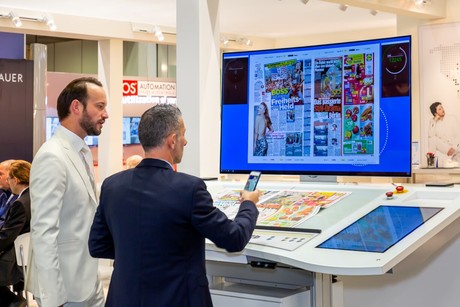The most important changes
- Newsshade [Instructions, 2.1]
Target and tolerance values for the technical participation categories 1 and 2 have been corrected in order to achieve a better agreement with the specifications of ISO 12647-3 for newsprint. - Dot gain increase at nominal 70% [Instructions, 2.3.2
In participation category 4 will be tested whether the dot gain in the 70% patch is less than in the 40% patch. Therefore the curve progression will be checked. The dot gain in the shadows must decrease.In der Teilnahmekategorie 4 wird getestet, ob die Tonwertzunahme im 70%-Feld geringer ist als im 40%-Feld. Es wird also der Kurvenverlauf geprüft. Die Tonwertzunahme muss in den Tiefen abnehmen. - Gray balance [Instructions, 2.4]Reference values are the newsshade of the paper and 4c black (CMYK) as basic parameters (brightest and darkest point) of the gray axis. This corresponds to the reality in the advertising business.
The “Cuboid” test element should be treated at the prepress and printing stage as a supplied colour ad. This also applies to the CMY gray areas (bright, middle and dark gray). Contained therein. For example, the black composition of the “Cuboid” data can be altered by so-called “ink saver” software. Likewise GCR (Grey Component Replacement) can be reinforced by image processing software. In the final instance, the gray areas should print out neutrally and as far as possible lie exactly on the gray axis that is formed by paper white and 4c black. - Colour conformity [Instructions, 2.6]
The evaluation structure has been simplified and is thus easier to comprehend. Firstly, it is checked whether the primary and secondary colours are within the specified Delta-E tolerances. Only if this is not the case will it then be established whether or not the measured colour lies outside the reference colour space (minimum chroma and maximum colour angle deviation). - General printing quality [Instructions, 2.8]
The number of evaluation criteria was reduced by combination. This makes it simpler for the jury members and clearer for the participants. Points will then be subtracted for show-through etc. only if a measurable threshold is exceeded. - New measuring technique
Because the colour measuring devices used to date had become somewhat old, the decision was taken to use a new measuring technique. This involves the use of two X-Rite “eXact” colour measuring devices. The new devices offer the following advantages for the evaluation carried out for the Color Quality Club:- The measuring devices are suitable for prepress and printing, online at the PC and offline, touch screen colour display for offline use, no measuring table required.
- Support of the measuring conditions M0 to M3 as specified by ISO.
- Colour and density (Status E) measurable in one pass.
- Wireless data transmission to the computer is possible.
- Cloud-based calibration via “Net-Profiler” possible to ensure inter-device agreement.
Manfred Werfel, Deputy CEO, Executive Director Competence Centre Newspaper Production & Special Projects, WAN-IFRA




